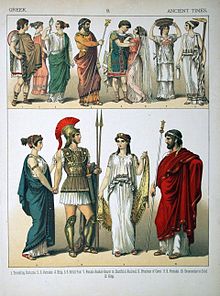Greek dress
Despite popular imagination and media depictions of all-white clothing, elaborate design and bright colors were favored.
A different border or trimming round the edges was very common, and many single stripes down the body or around the upper arm are seen, often denoting class or rank.
The races in the Hippodrome used four teams: red, white, blue and green; and the supporters of these became political factions, taking sides on the great theological issues.
The clothing of Muslims, Christians, Jewish communities, clergy, tradesmen state and military officials were strictly regulated during the reign of Suleiman the Magnificent.
[3] It follows the Biedermeier style, with a loose-fitting, white cotton or silk shirt, often decorated with lace at the neck and handcuffs, over which a richly embroidered jacket or vest is worn, usually of dark blue or claret velvet.
It was completed with a soft cap or fez with a single, long, golden silk tassel, traditionally worn by married women, or with the kalpaki (a toque) of the unmarried woman, and sometimes with a black veil for church.
This dress became the usual attire of all Christian townswomen in both Ottoman Empire-occupied and liberated Balkan lands as far north as Belgrade.




